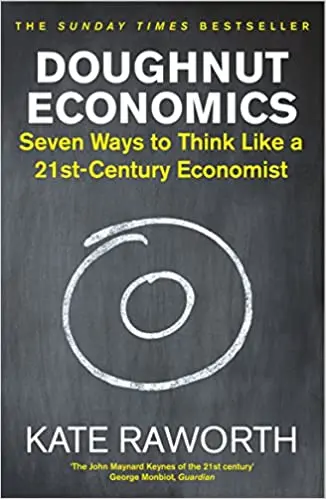Alan Thornett reviews Kate Raworth’s 2017 book Doughnut Economics: Seven Ways to Think Like a 21st-Century Economist. This article first appeared on Alan’s new website Ecosocialist Discussion.

Kate Raworth’s book Doughnut Economics: Seven Ways to Think Like a 21st-Century Economist was a best seller when it was first published in 2017. It was widely reviewed and translation into over 20 languages. George Monbiot described it as: “brilliant, thrilling, and revolutionary”. It would, he said, “change the world” and he described Kate Raworth as the “the John Maynard Keynes of the 21st century”.
Since then Raworth has founded the Doughnut Economics Action Lab in Oxford in order to further promote the book which has become increasingly influential. In fact, it has recently been adopted by the Green Group on the City Council in their response to a proposed new economic plan for Oxford titled Oxford’s Economic Strategy. They put it this way on their website:
“For too long we have had Local Plans in Oxford which are, frankly, undeliverable. Essentially, they have just been a long wish list of laudable – but often conflicting –objectives. This new Plan – which spans a critical decade in terms of delivering on sustainability – risks falling into that same trap. The Greens are therefore proposing that we adopt Kate Raworth’s Doughnut Economics as the lens through which our goals are set, balanced, and delivered”. Doughnut Economics, they said, are being used in cities around the world including Amsterdam, Berlin, and Rio de Janeiro (which indeed it has) – why not Oxford? It’s a good question.
The basic idea of Doughnut Economics is of two concentric rings, an inner ring that ensures that no one falls short of life’s essentials, and an outer ring that identifies the ecological limits (or planetary boundaries) beyond which crucial planetary life support systems would be destroyed. Between these two rings, she argues, lies a ‘doughnut shaped’ space that is socially just and ecologically safe within which humanity can both survive and thrive. It is a sort of magic doughnut that will change the mindset of economists for the rest of the century. To the extent that she has a programme it is about changing the language in which we discuss economics.
Her proposal relies heavily on two pre-existing concepts. The first is the circular economy, which advocates maximum recycling, minimum waste, maximum repurposing, and ending the throw-away society. The second is planetary boundaries, which monitor the carrying capacity of the key ecosystems of the planet and sound the alarm when they have been breached. Her aim, as she explains it, is to provide a compass to help “policymakers, activists, business leaders and citizens alike to steer a wise course through the twenty-first century”.
The problem, however, is not whether Doughnut Economics contains some useful environmental ideas, it clearly does, but whether it offers a strategic way out of the current
ecological and environmental crisis, and within the 10-year timescale sciences is giving us to do it which is the claim she is making. The answer to that, unfortunately, is no.
Seen from this angle the book is contradictory. On the one hand she sets out very clearly how exponential economic growth is destroying the biosphere of the planet.
“The global population stands today at 7.3 billion and is expected to reach almost 10 billion by 2050, levelling off at around 11 billion by 2100. Global economic output – if you believe business-as-usual projections – is expected to grow by 3 per cent a year from now until 2050, doubling the global economy by 2037 and almost trebling it by 2050. The global middle class – those spending between 10 and 100 US dollars a day – is set to expand rapidly from 2 billion today to 5 billion by 2030, bringing a surge in demand for construction materials and consumer products.” (p 5-6)
Unchecked exponential growth, she concludes, will always accelerate faster than we expect. A 3% growth rate, she says, might sound modest but it still doubles the economy every 23 years. The global economy would be nearly three times bigger by 2050 and over ten times by 2100. (p 248) Mainstream economics, she rightly argues, is in denial of the consequences of exponential growth, which it sees it still as essential to the survival of capitalist economies.
She then argues, in sharp contradiction, that it is not economic growth as such that is a threat to the future of the planet, but the way that growth is currently measured by Gross Domestic Product (GDP). GDP, she argues, should be abolished and replaced by doughnut economics, and that we should be come agnostic on economic growth! In fact, she devotes a whole chapter to this proposition entitled “Be Agnostic About Growth”. Suddenly “the doubling of the economy every 23 years” is to be ignored.
She accepts that her book does not contain practical proposals as to how to tackle the environmental crisis or halt global warming, but “a radically different way of thinking about economics in the 21st century” and a vision of what she calls “the commons” – areas where collaborative work can be undertaken. The problem, however, is not the yardstick that is the problem but exponential growth itself which clearly exists, is built into the logic of capitalist accumulation, and has to be challenged by a degrowth agenda and set of practical propositions to bring it about.
The ‘anthropogenic techno-mass’
We do not need GDP, however, to tell us that the global economy is expanding rapidly and at the rate she indicates – other yardsticks are available. We can take the ‘anthropogenic techno-mass’, for example. This is a measurement of all the ‘stuff’ that human beings churn out in order to live on this planet – roads, factories, houses, vehicles, railways, shipping, aviation, shopping malls, printing paper, plastic, computers, smartphones and all the other infrastructure of today’s daily life. This weighs in at a gigantic 1.1 trillion tonnes which is equal to the total natural global bio-mass of the planet, flora and fauna.
This techno-mass, moreover, doubles every 20 years, which not only reflects the anthropogenic impact on the planet but the same rate of increase measured by GDP.
This is not to defend GDP as a concept. It is a blunt instrument that misses out many factors that should be included – such as the environment. It does, however, provide a rough estimate of the rate of growth of the global economy and the anthropogenic impact on it that we ignore at our peril, and has been doing since 1937.
Monbiot’s conversion
Since Georg Monbiot wrote the superlatives about this book that are quoted at the top of this review he seems to have a rethink about growth.
Last August he published a book entitled This Can’t Be Happening (published by Penguin) in which he for the first time opposes economic growth and denounces it as a serious problem for the plant. He put it this way: “Beyond a certain point, economic growth, the force that lifted people out of poverty, curtailed deprivation, squalor and disease, tips us back into those condition. To judge by the devastation climate breakdown is wreaking, we appear to have already have reached this point.”
He followed it a month later with as article in The Guardian (of September 29th) in which he rightly said: ‘Green growth’ doesn’t exist – less of everything is the only way to avert catastrophe’ – and he is absolutely right. He went on to say that: “We have no hope of emerging from this full-spectrum crisis unless we dramatically reduce economic activity… Sustaining our life-support systems means doing less of almost everything. But this notion – that should be central to a new, environmental ethics – is secular blasphemy. This is a degrowth position.
The case for degrowth
The best case for degrowth, in my view is made by Giorgos Kallis his book of that name, which he concludes by saying: “Degrowth is not only ecologically necessary but also socially desirable. The pursuit of perpetual growth is a major obstacle to the achievement of a more equal society that lives in creative balance with the environment. Growth is fuelled by exploitation and cost-shifting. A sharing sociality cannot, and should not, be one that constantly expands, constantly creates new frontiers that only a few can access… If this is right then the future will be by necessity one of lower throughput – the question is will it be by design or disaster?”
Kallis is right. The planet cannot survive if the 20th century model of the throwaway society, particularly in the Global North continues. Vast amounts of commodities are churned out, driven by the advertising industry, that go from factory to landfill in very short periods of time.
The reality is that we desperately need an exit strategy from fossil fuel energy based on a socially and economically just transition, and a plan around which a mass movement can be built to fight for it. The problem with Raworth’s book is its lack of any practical propositions as to how such a transition can be achieved. Her central proposition, which is to make economists think differently by taking the environmental crisis fully into account – will not cut it. Even if, over a period of time, policy makers might adopt some of these her they would fall far short of the time frame we face.
Alan Thornett 4.5.2022



Alan Thornett is right that ‘exponential growth is built into the logic of capitalist accumulation’. Kate Raworth offers no strategy to challenge this, as Jordan Teicher argues in Jacobin:
‘doughnut economics fails to confront the power relations that stop the economy from serving most people’s needs. If there is an implicit notion in doughnut economics of how the status quo will change, it’s that capitalists, ostensibly presented for the first time with the idea of a more sustainable and socially just economy, will arrive en masse at the rational conclusion that business can’t go on as usual. … It’s a dubious theory, but it goes a long way toward explaining why doughnut economics is palatable to so many so-called progressive CEOs and other liberal elites, who rightly don’t perceive it as a threat.’
‘Doughnut Economics Has a Hole at Its Core’, Jacobin, September 2021.
https://jacobinmag.com/2021/09/doughnut-economics-raworth-amsterdam-capitalism-socialism